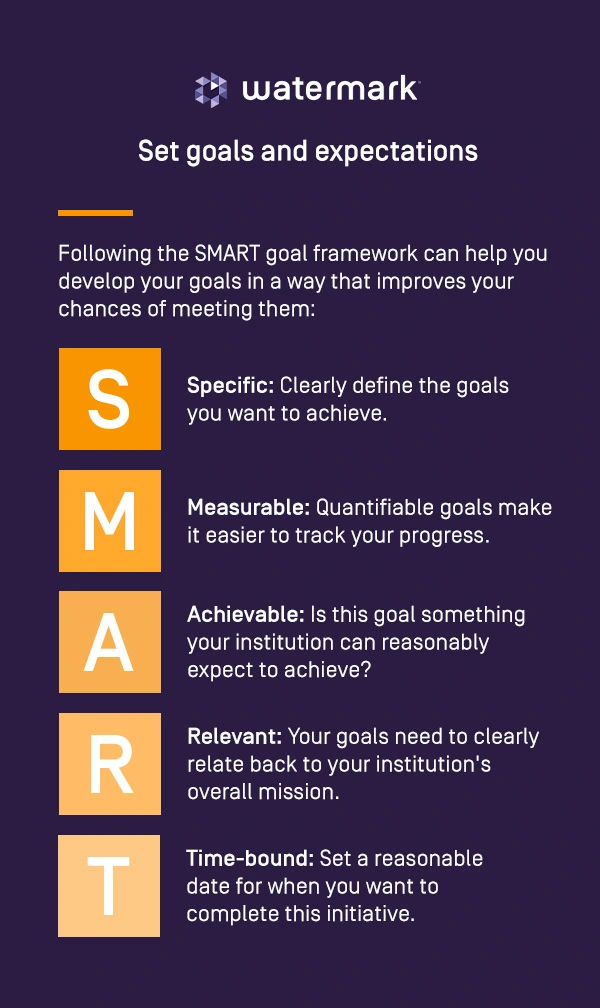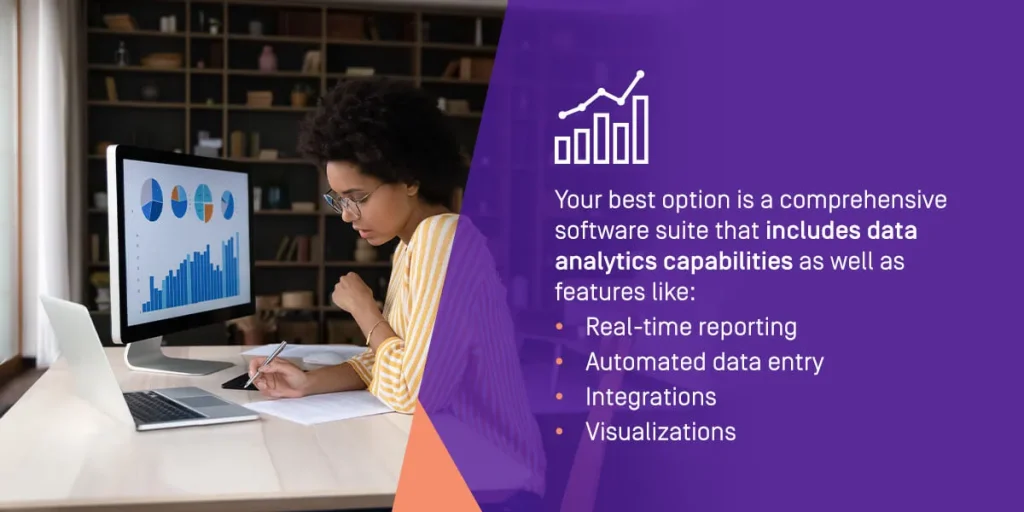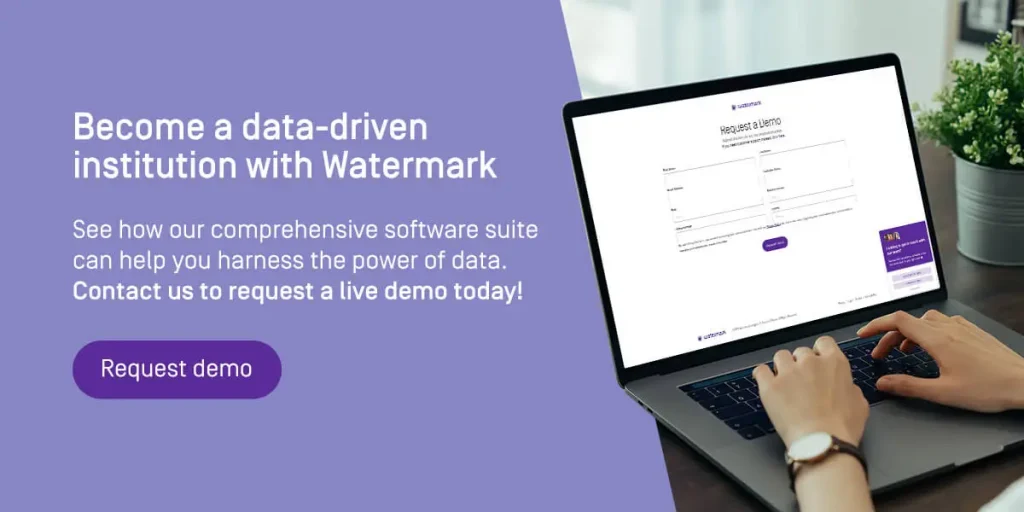



The world is changing faster than ever these days. New, disruptive technologies hit the market almost every month, and digital transformation has become a major priority in nearly every organization worldwide.
That’s why data-driven decision-making (DDDM) is such a hot topic in the business world. And while the world of academia is notoriously slow to change, DDDM has the power to revolutionize higher education as well.
While our culture places great importance on listening to your intuition, data is what drives real success. Whether you want to improve enrollment yield, reduce operational costs, or streamline resource management, data-driven decision-making is the process of using your institution’s data to make sound decisions that align with your overall business and educational goals.
Investing in the right analytics tools is essential for getting the most value out of your data. These tools pull valuable insights from your data that can inform your course of action. For example, if you want to increase diversity at your institution, you could analyze the current demographic makeup of your student body using your enrollment data.
Incorporating data science into your institution can help you improve your ability to stay afloat, even in the challenging times higher ed is currently facing.
Here are the five biggest benefits of adopting data-driven decision-making processes in higher education:
As with any new organizational initiative, implementing data-driven decision-making is a journey that requires careful planning. You’ll need to invest significant talent, time, and money into this journey to see the results you want — and figuring out where to start can be more difficult than you may expect. Here’s a quick guide to building a data-driven culture in your institution.
Before you begin your journey, it’s important to ask: What do you expect from this change? Where do you want your institution to be, and how will a data-driven approach to institutional decision-making get you there?

Following the SMART goal framework can help you develop your goals in a way that improves your chances of meeting them:
You can’t fully embrace data-driven decision-making without first developing a strong data-first culture within your institution. A truly data-driven organization turns to the facts first instead of relying on assumptions or gut feelings.
It’s common for faculty and staff to resist large-scale changes like this, which can make your goals significantly harder to achieve. But when you consider that your institution is already collecting the data you need to begin making data-driven decisions, you have a strong argument for a transformation.
Clear communication is key here. Be completely transparent with your key stakeholders in answering any questions they may have to ensure they understand the importance of your decisions. Additionally, it’s important to communicate your victories any time a data-driven decision results in success — celebrating your wins will help keep motivation high and promote lasting success.
While building a robust foundation is key for success, so is getting strong buy-in from the people at the top of your institution. From university presidents to department heads, all institutional leaders play a vital role in driving cultural change.
When your leaders act with a sense of urgency, they inspire the people below them to do the same. However, that doesn’t mean acting rashly. It’s still important to honor higher education’s legacy of collaboration and research, even as you prioritize timely decisions and action.
A well-planned implementation roadmap gives you a clear path to follow so you can maintain your focus and keep your project moving according to schedule.
That said, it’s important to be realistic with your expectations. Setting goals that are too ambitious can have the opposite effect, putting excess pressure on your institution and sabotaging your efforts. Take the goals you outlined in the first step and break them down into all the smaller tasks your process will include, such as:
Remember that there will be an adjustment period as everyone gets used to your new processes and tools. If you implement new software, you’ll need to provide your faculty and staff with adequate training so they know how to use it. And when they feel more confident in using your software, they’ll be more likely to embrace it in their day-to-day functions.
Your institution already collects massive quantities of data about your students, faculty, and staff. Supporting and processing it all requires a robust digital infrastructure.

Your best option is a comprehensive software suite that includes data analytics capabilities as well as features like:
Look for the most user-friendly, intuitive solution available. All new software comes with a learning curve, but streamlined software with simplified navigation can help cut down on the time it takes to learn the interface.
While analytics tools are essential for extracting actionable insights from your data, you still need to ensure everyone who needs to use your data can do so. A centralized data hub consolidates all your institution’s data into one place for easy analysis so anyone can get the insights they need when they need them.
That said, you don’t want just anyone manipulating your data. The best data analytics tools come with built-in security features you can use to protect your information.
For example, access management techniques like multi-factor authentication will help you grant access to anyone who needs it while limiting the resources others can use. End-to-end encryption prevents unauthorized users from reading your data even if they manage to gain access to it.
Additionally, interactive dashboards allow users to drill down to the most important insights for their applications. For example, financial aid professionals can analyze student demographics to ensure students with the most need receive sufficient aid to stay in school. And department heads can evaluate whether students in specific courses are meeting expectations for learning outcomes to make improvements to the curriculum.
We can’t stress enough that data-driven decisions make a real impact. And when users don’t understand the data they’re processing — or the underlying methods used to process that data — they can inadvertently make decisions that negatively affect your institution.
For example, although predictive analytics can identify at-risk students by analyzing behavioral trends such as missed classes and declining grades, it can also perpetuate bias if not implemented properly. In this case, the software could target the wrong students and affect your retention efforts.
Training faculty and staff on ethical data usage is critical. Users must remember that individual data points do not provide the whole picture of the student, and that getting to know students as people first is the best way to improve their chances of success.
Data security is a real concern for students and their families. The education sector is a top target for cybercriminals — according to Verizon’s annual Data Breach Investigations Report (DBIR), educational services experienced 497 data breaches in the first half of 2023. Most attacks came from outside the institution, and personal information was the most common target.
Following data security best practices is essential for protecting student information from malicious actors. Regularly update all your software, and conduct frequent security assessments to proactively address vulnerabilities within your network.
It can also help to look into advanced cybersecurity technologies such as identity and access management (IAM), which can help you restrict system access to only the people who need it for their jobs.
You can implement data-driven decision-making into every level and department of your institution — and you should. The more you can encourage your institutional decision-makers to refer to the facts rather than their gut feelings, the more likely your institution is to see real improvements.

Here are some examples.
Data pulled from course evaluations and student surveys provide valuable insights into potential curriculum improvements, but organizing and processing all that information manually is time-consuming — especially when you’re looking to make changes to your curriculum before the next academic year.
Rubric-based assessment features allow you to understand how well your existing curricula meet your intended learning outcomes. Plus, analytics capabilities and real-time reporting provide accurate recommendations for improvement, so you know right away where your efforts will have the most impact.
Faculty data from student surveys and course evaluations can help administrators gain valuable insight into an instructor’s effectiveness as a teacher and the value of their courses — vital information for tenure and promotion decisions.
Faculty success solutions provide an accessible, centralized hub for all evaluation data, faculty achievements, and records of scholarship. Administrators can easily access and manipulate this data to showcase each faculty member’s accomplishments or to determine which instructors to award tenure to.
A unified solution can help streamline accreditation assessments by tracking all faculty activity throughout their entire career. Assessment professionals can easily find the information they’re looking for, saving you valuable time and energy.
Even though most institutions offer extensive support services to help struggling students get back on track, many students still defer or discontinue their education when they experience difficulty. But when faculty can intervene early, those students have a much higher chance of completing their course of study.
Student success solutions use predictive analytics to identify at-risk students based on data factors like changes in their academic performance or class attendance. In addition to automatically notifying student support teams, the software can also recommend the most effective course of action for getting the student back on track.
Embracing data in your institutional decision-making processes will be essential as we move into this new age of education. At its heart, though, data-driven decision-making is about more than just the numbers. It’s about using those numbers to better serve your students and faculty.
That truth is what forms our mission at Watermark. We’re dedicated to helping higher education institutions make the most of the data they already collect. Our integrated software solutions unlock access to powerful insights that have transformed the way many of our customers serve their students.
See how our comprehensive software suite can help you harness the power of data. Contact us to request a live demo today!






























































































































































































































































































































































































